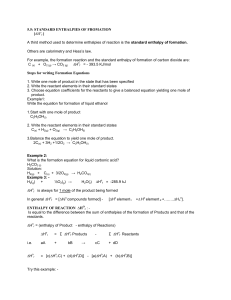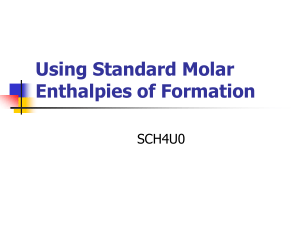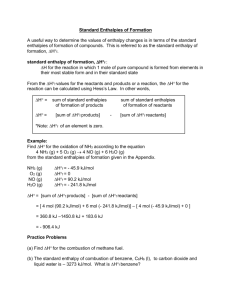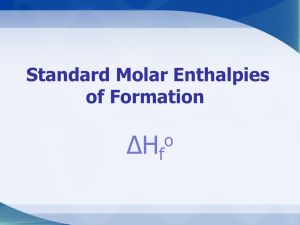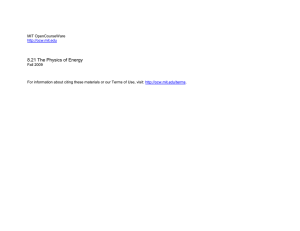Standard Enthalpies of Formation (Fall 2012)
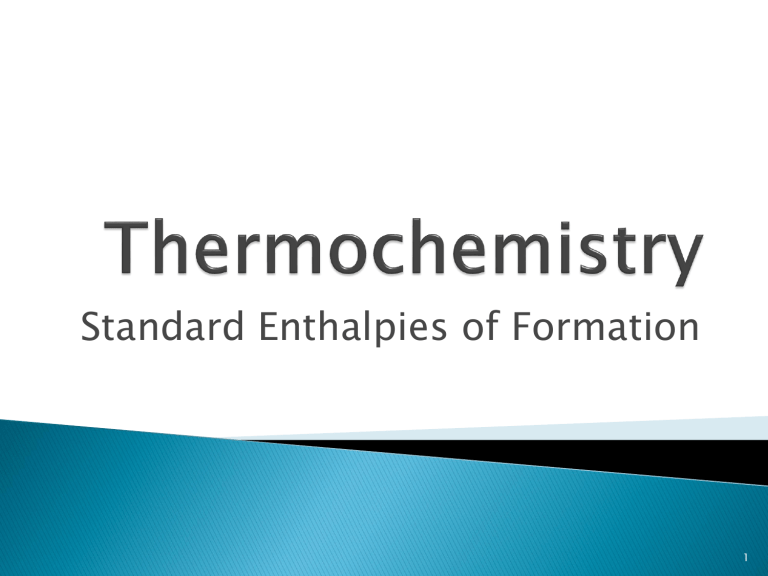
Standard Enthalpies of Formation
1
Standard Enthalpies of Formation
Tabulated enthalpy changes called standard enthalpy of formation (∆Hº f
) can also be used to determine enthalpies of reaction (Nelson textbook pp. 799-800)
Standard enthalpy of formation is the quantity of energy associated with the formation of one mole of a substance from its elements in their standard states
C
(s)
+ O
2(g)
CO
2(g)
∆Hº f
= -393.5 kJ/mol
2
How to write formation equations
1. Write one mole of product in the state that has been specified.
2. Write the reactant elements in their standard states.
Remember,
Most metals are monoatomic solids
(Mg
(s)
, Ca
(s)
, Fe
2(g)
, H
(s)
, Au
2(g)
)
(s)
, Na
(s)
)
Some nonmetals are diatomic gases
(N
2(g)
, O
Halogen family show a variety of states
(F
2(g)
, Cl
2(g)
, Br
2(l)
, I
2(s)
)
3
3. Choose equation coefficients for the reactants to give a balanced equation yielding one mole of product.
Example 1
Write the equation for the formation of liquid water directly from its elements.
H
2(g)
+ ½ O
2(g)
H
2
O
(l)
∆Hº f
= -285.8 kJ
4
Example 2
Write the equation for the formation of solid calcium carbonate directly from its elements.
Ca
(s)
+ C
(s)
+ 3/2 O
2(g)
CaCO
3(s)
∆Hº f
= -1206.9 kJ
5
Using Standard Enthalpies of Formation
Generalization to all elements in their standard states ∆Hº f for Elements, the standard enthalpy of formation of an element already in its standard state is zero
Thus, the ∆Hº f are all zero for Fe
(s)
, O
2(g)
, and Br
2(l)
6
We can apply Hess’s Law to predicting the energy changes for many reactions
The enthalpy change for any given equation equals the sum of the enthalpies of formation of the products MINUS the sum of the enthalpies of formation of the reactants
∆H° r
= ∑ n∆Hº f (products)
- ∑ n∆Hº f (reactants)
7
Using Standard Enthalpies of Formation to
Calculate Enthalpy Changes
∆H° r
= ∑ n∆Hº f (products)
- ∑ n∆Hº f (reactants)
Determine the enthalpy change for the complete combustion of methane, CH
4(g)
CH
4(g)
+ 2O
2(g)
CO
2(g)
+ 2H
2
O
(g)
∆H =
[1mol (∆Hº of CO
- [1mol (∆Hº f of CH
) + 2mol (∆Hº
4(g) f of H
) + 2mol (∆Hº f
2
O of O
(g)
)]
2(g)
)]
8
Substitute the standard enthalpies of formation from Appendix C to get the following calculation.
∆H° r
=
[1mol (-393.5 kJ/mol) + 2mol (-241.8 kJ/mol)]
– [1mol (-74.8 kJ/mol) + 2mol (0 kJ/mol)]
= -802.3 kJ/mol of CH
4(g)
9
∆H° r
= ∑ n∆Hº f (products)
- ∑ n∆Hº f (reactants)
Practice
Use standard enthalpies of formation to calculate the standard enthalpy change for the oxidation of ammonia represented by the following balanced equation:
4 NH
3(g)
+ 5 O
2(g)
6 H
2
O
(g)
+ 4 NO
(g)
10
How does this method of adding heats of formation relate to
Hess’s Law?
11
Target Equation: CH
4(g)
+ 2O
2(g)
CO
2(g)
+ 2H
2
O
(g)
Consider the equations for the formation of each compound that is involved in the reaction of methane with oxygen.
(1) H
2(g)
(2)
(3)
C
+ ½ O
2(g)
H
2
O
C
(s)
(s)
+ O
+ 2H
2(g)
2(g)
(g)
CO
2(g)
CH
4(g)
∆Hº f
∆Hº f
∆Hº f
= -241.8 kJ
= -393.5 kJ
= -74.6 kJ
There is no equation for the formation of oxygen, because oxygen is an element in its standard state.
12
p. 332 Practice UC # 1 p. 335 Practice UC # 2, 3, 4 p. 335 Correct Answers
4(a) 205.7 kJ
4(b) -41.2 kJ
13

